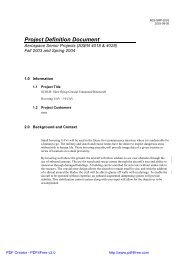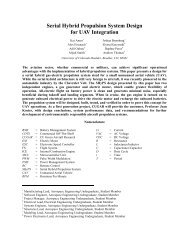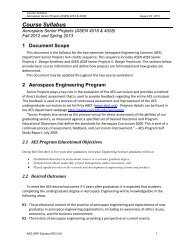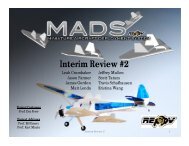PFR - Aerospace Engineering Sciences Senior Design Projects ...
PFR - Aerospace Engineering Sciences Senior Design Projects ...
PFR - Aerospace Engineering Sciences Senior Design Projects ...
You also want an ePaper? Increase the reach of your titles
YUMPU automatically turns print PDFs into web optimized ePapers that Google loves.
Project Final Report – CUDBF April 30 th , 2009<br />
ASEN 4028: <strong>Aerospace</strong> <strong>Senior</strong> <strong>Projects</strong><br />
<br />
=<br />
<br />
<br />
∙ ∙ <br />
<br />
<br />
<br />
<br />
1<br />
<br />
<br />
<br />
+ <br />
<br />
<br />
∙ ∙ ∙ ∙ <br />
∙ <br />
<br />
∙ <br />
∙ <br />
<br />
<br />
<br />
<br />
Equation 11: Weight-to-Power ratio for cruise speed.<br />
In Equation 11, is the dynamic pressure based on the ambient density, and cruise velocity,<br />
is the parasitic drag, <br />
<br />
is the takeoff thrust to cruise thrust ratio, is the Oswald efficiency<br />
factor of the wing, is the aspect ratio of the wing, <br />
<br />
is the ratio of the cruise weight to the<br />
takeoff weight, is the wing loading and <br />
is the cruise speed. A detailed list of the<br />
assumptions and values used to size this aircraft can be seen in Appendix F. The equations used<br />
to do the performance sizing were obtained from Roskam [11] .<br />
The design point chosen from this design area is also marked in the plot. This design point gave<br />
a wing loading, W/S of 2.1 lb/ft 2 and a weight to power ratio, W/P of 0.047 lb/lb ft/s. Using an<br />
estimated gross takeoff weight of 15lb, the wing area necessary from the wing loading was<br />
determined to be 7.14 ft 2 . The power required from the weight to power ratio was determined to<br />
be 530 W. The performance sizing shown demonstrates that a number of designs that meet all<br />
the performance requirements for stall, takeoff and cruise are feasible, and an optimized design<br />
can be created that would maximize the cruise speed while keeping the weight to power ratio<br />
small.<br />
7.1.4 Propulsion Feasibility<br />
To ensure that the propulsion system can meet all the design to specifications, a feasibility study<br />
was conducted. The two major requirements to verify are the 100 ft takeoff distance and the<br />
maximum 4 lb battery weight. The rest of the requirements can be verified by inspection. In<br />
order to make the 100 ft takeoff, the thrust required from the motors was calculated. The<br />
equation for takeoff distance is in Equation 12.<br />
S<br />
LO<br />
=<br />
g * ρ * S * C<br />
L<br />
2<br />
1.44 * W<br />
*{ T − [ D + µ * ( W<br />
r<br />
− L)}<br />
Equation 12: Takeoff Distance Calculation<br />
To simplify the equation, it is assumed that drag, D is very small compared to thrust and that the<br />
coefficient of friction, µ of the landing gear wheels is negligible. This yields the simplified<br />
version solved for thrust in Equation 13.<br />
r<br />
54
















